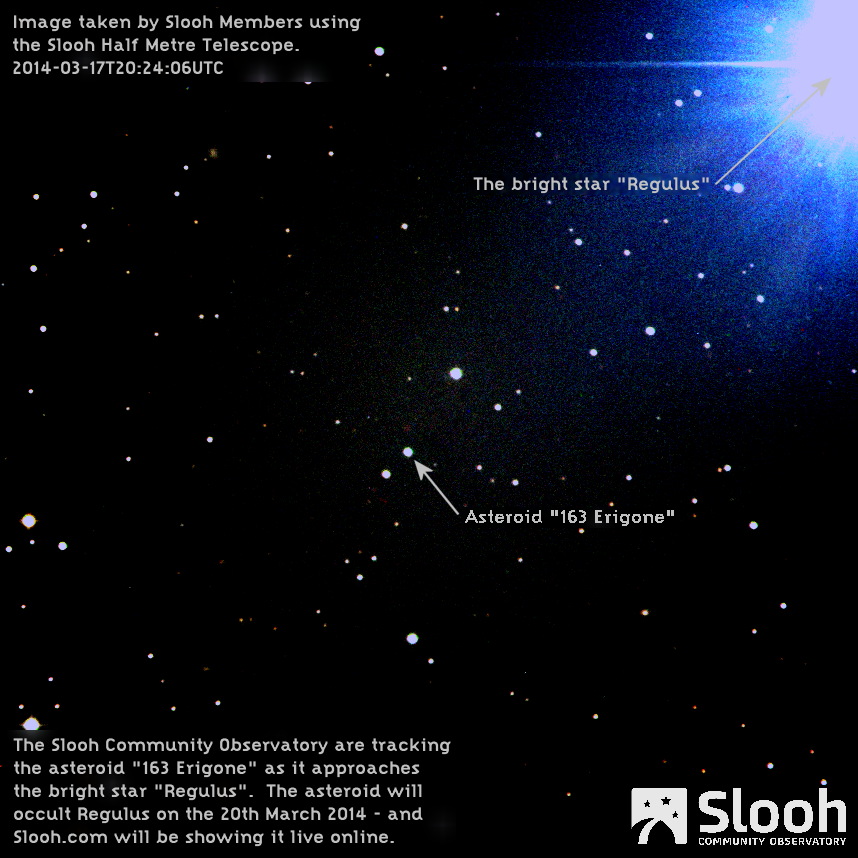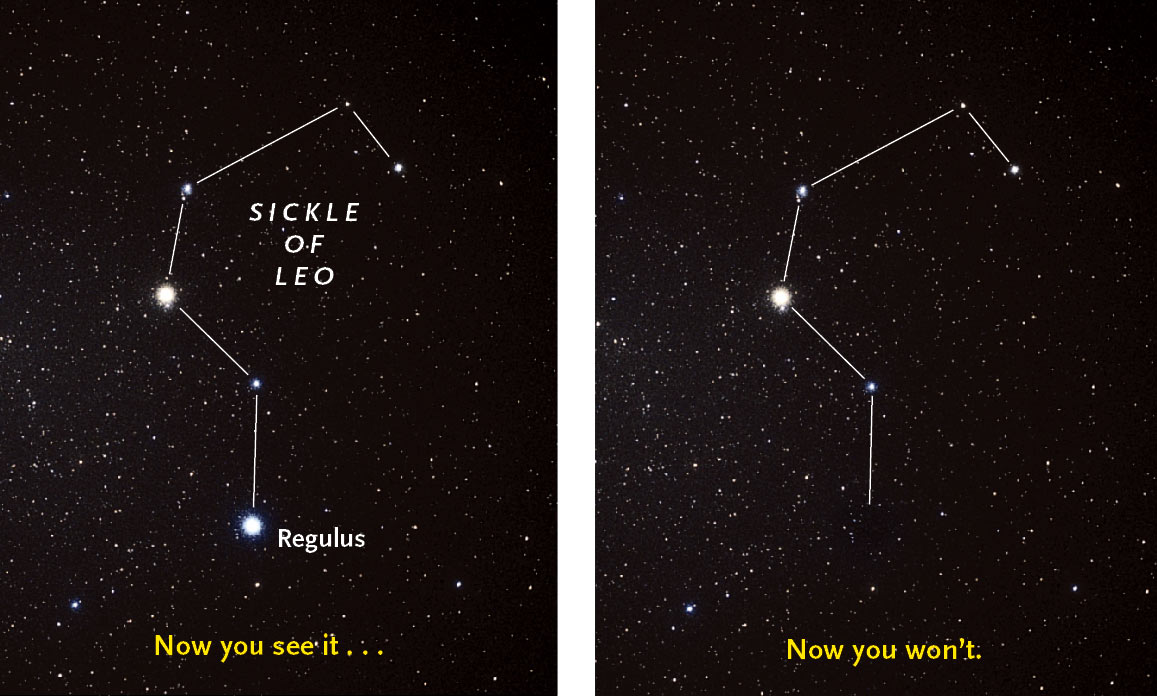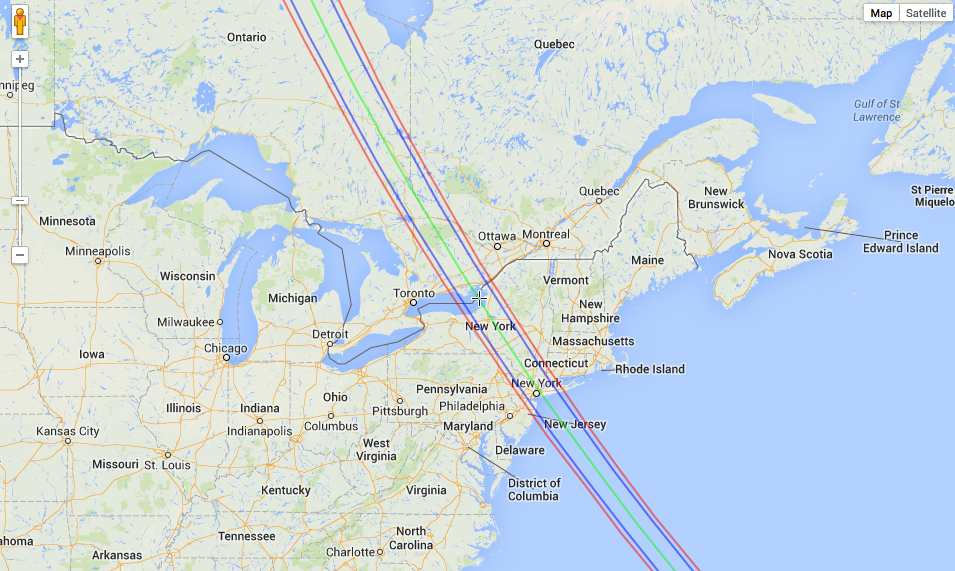Super-Rare Asteroid Eclipse of Bright Star Occurs Thursday: How to See It

An exceedingly rare celestial event will occur in the wee hours of Thursday (March 20), when an asteroid will briefly hide from view one of the brightest stars in the sky, as seen from Earth.
The asteroid in question is 163 Erigone, located within the "main belt" of asteroids that lie chiefly between the planets Mars and Jupiter. The asteroid will hide the star Regulus, a bluish star of the first magnitude that is the brightest star in the constellation of Leo, the Lion. Regulus is located at the bottom of a “backwards question-mark” star pattern popularly known as the "Sickle" of Leo.
The asteroid "occultation," as astronomers call it, will only be visible from parts of North America, weather permitting. Asteroid 163 Erigone will make Regulus appear to "wink out" at about 2 a.m. EDT (0600 GMT) for between 14 seconds and up to two minutes, depending on your viewing location. [Rare Asteroid Eclipse of Star Regulus: A Photo Guide]
However, you can watch the event live online, courtesy of the online Slooh skywatching website, beginning at 1:45 a.m. EDT (0545 GMT) on Thursday. You can also see the asteroid and Regulus webcast on Space.com.
The asteroid 163 Erigone is a namesake of the Erigone family of asteroids that share similar orbital elements and characteristics. It was discovered by French astronomer Henri Joseph Perrotin on April 26, 1876 and named after one of the two Erigones in Greek mythology. This is a relatively large, dark asteroid with an estimated diameter of about 45 miles (72 km). Based upon its spectrum, it probably has a carbonaceous composition which is the most common variety, forming around 75-percent of all known asteroids.
How to find Regulus
The Sickle of the Leo constellation can be positively identified by using the bowl of the Big Dipper. The star that joins the bowl with the handle is Megrez and the star immediately below it is called Phecda.
Breaking space news, the latest updates on rocket launches, skywatching events and more!
Extend an imaginary line from Megrez through Phecda southward and you will eventually come to the Sickle which will be standing roughly halfway up in the southwest sky and tilted down toward the right. Congratulations, you've found Regulus!
Again, Regulus will be the bottom star of the Sickle.
A rare cosmic sight for millions
Calculations show that the roughly 67-mile-wide (108 kilometers) path of the asteroid's shadow will move on a southeast-to-northwest trajectory and will extend from New York City — as well as adjacent western and central Long Island, a slice of northeast New Jersey and part of southwestern Connecticut — up to Oswego in New York State. The visibility region extends approximately northwest across the length of Ontario that includes Belleville and North Bay, and continues up to the Hudson Bay shore of Manitoba.
This will be the very first time in history that an occultation of such an obvious naked-eye star will be evident over such a large, heavily populated area. An estimated 20 million people live within the predicted track of the asteroid's shadow. [11 Must-See Skywatching Events for 2014]
Astronomers use a magnitude scale for the brightness of objects in the night sky. On the scale, brighter objects are indicated by lower numbers, while dimmer hard-to-see objects get higher numbers.
When the magnitude +12.4 Erigone occults the magnitude +1.4 Regulus, it will appear to dim the star by a factor of over 25,000. The human eye can discern objects in the night sky as dim as magnitude +6.
Out like a light!
Those who are watching at just the right moment with just their eyes will see an amazing sight: Regulus will seem to abruptly disappear as if a switch had been thrown. Regulus will remain invisible for up to 14 seconds (for those situated along the center of the path); an incredible, albeit very brief occurrence.
To get an idea of what this effect should look like, check out this video by amateur astronomers Mike Kentrianakis, Dave Cartenuto and Dick Rinehart that simulates the "winking out" of Regulus.
Depending upon where you are located along the path, this total eclipse of a star will take place sometime between 2:06 EDT (NYC area) and 2:08 a.m. EDT (southern Ontario) early on Thursday morning, March 20.
The shadow of 163 Erigone will be moving over the Earth at a very rapid speed of 11,400 miles (18,300 km) per hour; moving as rapidly as this one cannot expect Regulus to remain hidden for very long. That is why 14 seconds is considered the absolute maximum for those situated along the middle of the projected path and a shorter, uncertain duration for those located off of the center of the track.
Mike Kentrianakis, Dave Cartenuto and Dick Rinehart also developed this animation of the asteroid's shadow moving on the Earth in concert with a clock which is counting down the time to the nearest hundredth of a second. "This animation is an approximation based on predicted data that may be inaccurate by 20 percent to 30 percent," they note.
The predicted track
For a more accurate prediction, amateur astronomer Geoff Hitchcoxof the International Occultation Timers Association (IOTA) has developed this interactive Google Earth map of the asteroid occultation, depicting the track where asteroid 163 Erigone will appear to hide Regulus.
Zooming in on Hitchcox'smap, the blue lines represent the predicted east-west limits of the occultation zone based on the 67 mile shadow width of 163 Erigone. The green line represents the center line of the path with the likelihood of maximum duration like the center line of a solar eclipse path. The red lines show the remaining position uncertainty of the path edges with a confidence level of 66 percent. In other words, the actual path has a 66 percent chance of falling entirely between the red lines (the 1-sigma uncertainty zone).
But also be prepared for last-minute updates which could shift the path somewhat.
Incidentally, Bermuda is located on the eastern edge of the shadow path and might see Regulus briefly wink out at around 3:02 a.m. Atlantic Daylight Time.
Where to learn more
For more information, IOTA has set up a dedicated web page at: http://occultations.org/Regulus2014/
Check there for the latest news and information should you wish to time this rare event either visually or by video and where you can submit your results. There is also a Facebook page dedicated to this event at: https://www.facebook.com/Regulus2014
Says Ted Blank of IOTA: "On the morning of the 19th I hope we'll have the best possible weather prediction, and hopefully it will include someplace along the path with clear skies. I'll update the Facebook page with this information. Also, please remember that Regulus is so bright that thin clouds will not obscure it, esp. with binoculars or a small telescope. So don't let a bit of cloud cover bother you on the 20th."
And lastly, for those who might be concerned that 163 Erigone might pose a danger to Earth, don’t sweat this. The asteroid is in a stable orbit about 110 million miles (177 million km) from Earth in the Asteroid Belt and is in no way a danger to us.
For those within the path, good luck and clear skies!
Editor's note: If you snap a great photo of rare asteroid occultation of the star Regulus, or any other night sky view, and would like to share it with Space.com for a story or gallery please send comments and images to managing editor Tariq Malik at: spacephotos@space.com.
Joe Rao serves as an instructor and guest lecturer at New York's Hayden Planetarium. He writes about astronomy for Natural History magazine, the Farmer's Almanac and other publications, and he is also an on-camera meteorologist for News 12 Westchester, N.Y. Follow us @Spacedotcom, Facebook and Google+. Original article on Space.com.

Joe Rao is Space.com's skywatching columnist, as well as a veteran meteorologist and eclipse chaser who also serves as an instructor and guest lecturer at New York's Hayden Planetarium. He writes about astronomy for Natural History magazine, Sky & Telescope and other publications. Joe is an 8-time Emmy-nominated meteorologist who served the Putnam Valley region of New York for over 21 years. You can find him on Twitter and YouTube tracking lunar and solar eclipses, meteor showers and more. To find out Joe's latest project, visit him on Twitter.




